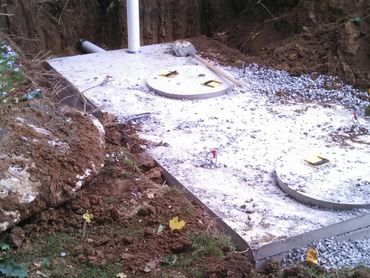INSTALLATION
Before any system can be installed soil tests will need to be performed. First a soil probe or probe test pit is excavated to determine the depth to a limiting zone, or simply stated a hole is dug to determine the depth of good soil. Next a percolation test will need to be completed to help measure the absorption rate. The results of the probe test and the percolation test will tell our technician what system can be placed in the ground and how large it must be. Our technician will then create a design to provide to the sewage enforcement officer (SEO)for approval of a permit. Once approved we can then start the process of installing the new system.
FROM DESIGN TO INSTALL. WE DO IT ALL!
SOIL TESTS

PROBE TEST
This test is dug as deep as eight feet into the ground. The SEO enters the pit to examine the soil and determine the suitability of the soil for a septic system. If the soil is determined suitable then a percolation test will be performed.

PERCOLATION TEST
A percolation test measures the rate at which water moves through soil. The test is to determine if the soil will allow water to drain quickly enough to support a properly working septic system.
A minimum of six holes are dug in the area of the proposed absorption field where the soil is soaked to reproduce wet season. The actual test begins with a series of measurements of water level drop in intervals.
ADDITIONAL INFORMATION
COST OF AN INSTALLATION
Having a septic tank installed requires more than just placing an order for a new system. Many factors go into choosing a tank and ultimately system costs. There are several things to consider when pricing a system.
HOUSE AND GALLON SIZE
The size of a residential home typically determines the septic tank size needed. The larger the house, the more the occupancy and the more potential for increased water usage. The tank size is determined by the number of bedrooms in a residential house.
TYPE OF SYSTEMS
Above Ground Systems – Elevated Sand Mound Beds / Elevated Sand Mound Trenches / At Grade Beds / Eljeen Beds
Aerobic Systems – Advanced Treatment Systems
Conventional Septic System – Seepage Beds / Trench Systems
Chamber Septic Systems
Individual Residential Spray Irrigation System
Drip Systems
MATERIALS
Concrete is a solid option for septic tanks and is one of the homeowners’ most common tank choices. When properly maintained, these tanks can last between 20 to 30 years.
Plastic and fiberglass tanks are lighter and easier to place on the ground. However, they can be more fragile than concrete and can easily become damaged and crack.
RISER AND LID
Septic tanks are buried under the ground for proper sewage flow and to be safely out of the way. Every tank we install will have an easy access cover to allow proper pumping and maintenance at every time of service.



Copyright © 2024 Thomas H. Erb & Sons. Inc. - All Rights Reserved.
Powered by GoDaddy
